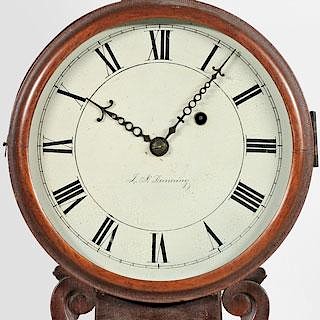Thomas Wilfred's "Clavilux Junior,"
Lot 262
About Seller
Bonhams Skinner
274 Cedar Hill Street
Marlborough, MA 01752
United States
Founded over four decades ago, Bonhams Skinner offers more than 60 auctions annually. Bonhams Skinner auctions reach an international audience and showcase the unique, rare, and beautiful in dozens of categories, including the fine and decorative arts, jewelry, modern design, musical instruments, sc...Read more
Categories
Estimate:
$3,000 - $5,000
Absentee vs Live bid
Two ways to bid:
- Leave a max absentee bid and the platform will bid on your behalf up to your maximum bid during the live auction.
- Bid live during the auction and your bids will be submitted real-time to the auctioneer.
Bid Increments
| Price | Bid Increment |
|---|---|
| $0 | $10 |
| $100 | $25 |
| $500 | $50 |
| $1,000 | $100 |
| $3,000 | $250 |
| $5,000 | $500 |
| $10,000 | $1,000 |
| $30,000 | $2,500 |
| $50,000 | $5,000 |
| $100,000 | $10,000 |
| $300,000 | $25,000 |
| $500,000 | $50,000 |
| $1,000,000 | $100,000 |
About Auction
By Bonhams Skinner
Apr 25, 2015 - Apr 26, 2015
Set Reminder
2015-04-25 10:00:00
2015-04-26 10:00:00
America/New_York
Bidsquare
Bidsquare : Clocks, Watches & Scientific Instruments
https://www.bidsquare.com/auctions/skinner/clocks-watches-scientific-instruments-573
Bonhams Skinner bidsquare@bonhamsskinner.com
Bonhams Skinner bidsquare@bonhamsskinner.com
- Lot Description
Thomas Wilfred's "Clavilux Junior," Clavilux Laboratories, New York, May 1930, walnut veneered Art Deco cabinet housing the convex white screen, upper and lower colored bulbs in the upper section of the cabinet, bottom section with remote control, pierced disc turntable to allow light to filter through for projection of colored glass discs, light projection tube, and disc storage, original typed label reading The Clavilux Junior Model P.X K 100-CW Patented #85 May 1930 This instrument sold for amateur use only. It can not be used for lecturing, advertising or for any public display. Thomas Wilfred, clear 8-in. glass disc with five various prism shapes, six colored disc with labels reading in part Clavilux Junior with record numbers OP 72 through OP 76, six clear glass discs, cabinet ht. 68 in.
Note: The Clavilux, developed in the early 1920s by Thomas Wilfred, was the first and most famous experimental color-instrument, at that time referred to as "Lumia." The Clavilux employed several projectors and filters that allowed light to dance across the screen which was controlled by a keyboard or console comprising of sliders. A complicated arrangement of prisms that could be twisted or distorted on a plane in front of the light source with the color strength being manipulated by separate rheostats which was operated by the performer or artist. Introduced in New York in 1922, in 1925 the Clavilux went on an extensive recital tour throughout the Unites States, Canada, and Europe, with some comparing the performance or display to the Aurora Borealis, or "music for the eye."
The Art Institute of Light was set up by Wilfred at the Grand Central Palace in New York where he gave regular performances up until WWII. After WWII, Museum of Modern Art (MoMA) curator Dorothy Miller included Wilfred's "Lumia" or "light played by key" in the 1952 exhibition titled Fifteen Americans, which also included Jackson Pollock and Mark Rothko. More recently, his work was included in Terrence Malick's movie Tree of Life in 2011.
For more information please see Ken Peacock's article in Leonard, November 1991; Jen Graves in The Stranger, 2014.
Estimate $3,000-5,000
The absence of a condition statement does not imply that the lot is in perfect condition or completely free from wear and tear, imperfections or the effects of aging. Condition requests can be obtained via email (lot inquiry button) or by telephone to the appropriate gallery location (Boston/617.350.5400 or Marlborough/508.970.3000). Any condition statement given, as a courtesy to a client, is only an opinion and should not be treated as a statement of fact. Skinner Inc. shall have no responsibility for any error or omission. - Shipping Info
-
Please visit http://www.skinnerinc.com/services/payment-and-shipping/ for information regarding the collection of items purchased at auction.
-
- Buyer's Premium



 EUR
EUR CAD
CAD AUD
AUD GBP
GBP MXN
MXN HKD
HKD CNY
CNY MYR
MYR SEK
SEK SGD
SGD CHF
CHF THB
THB














